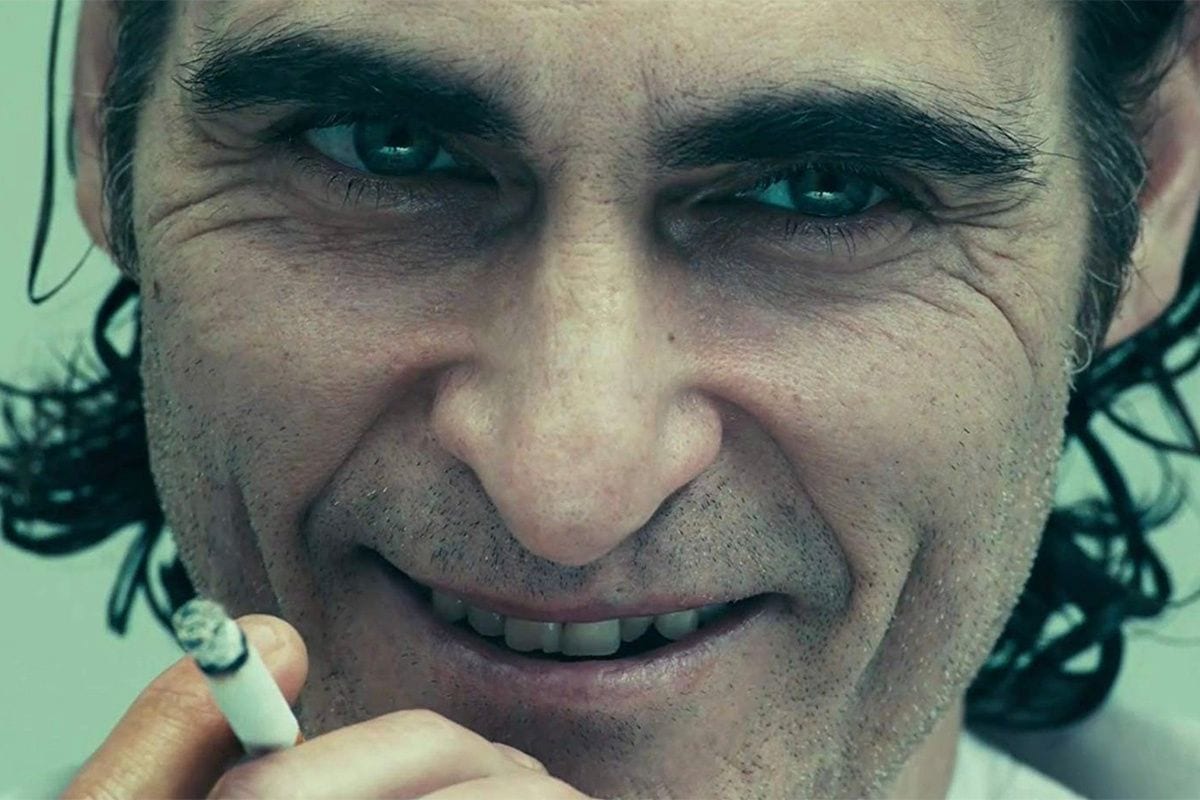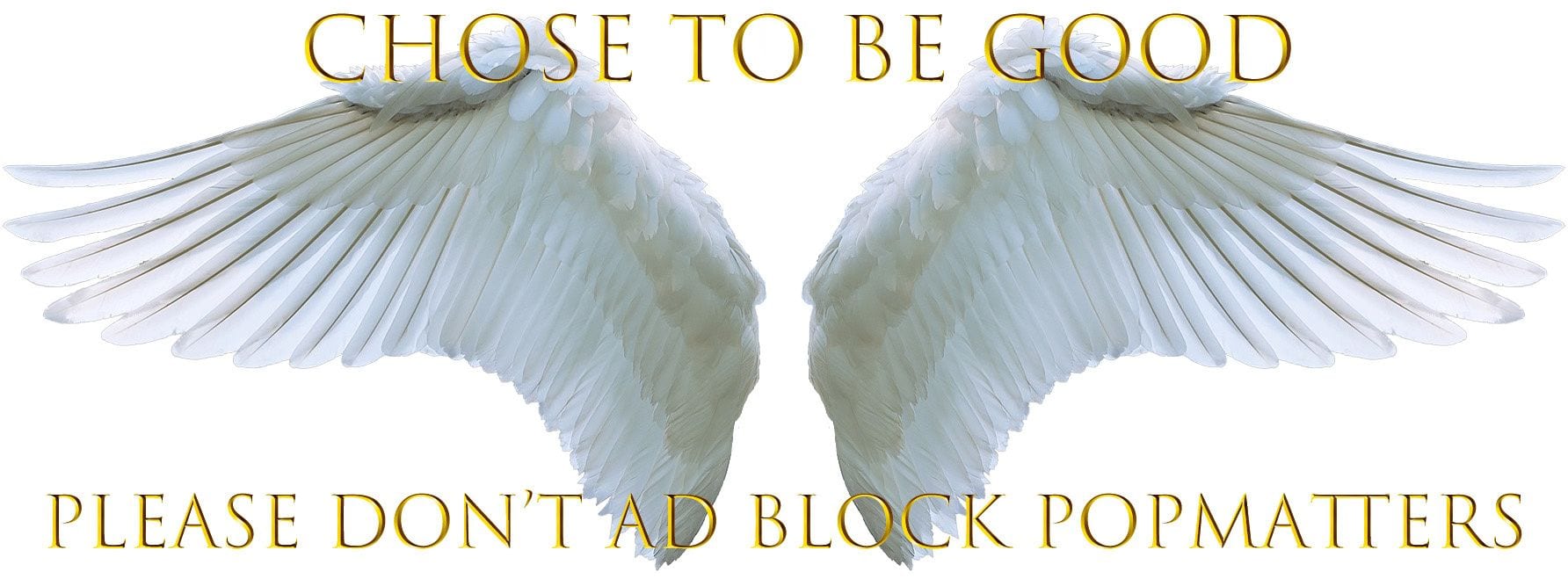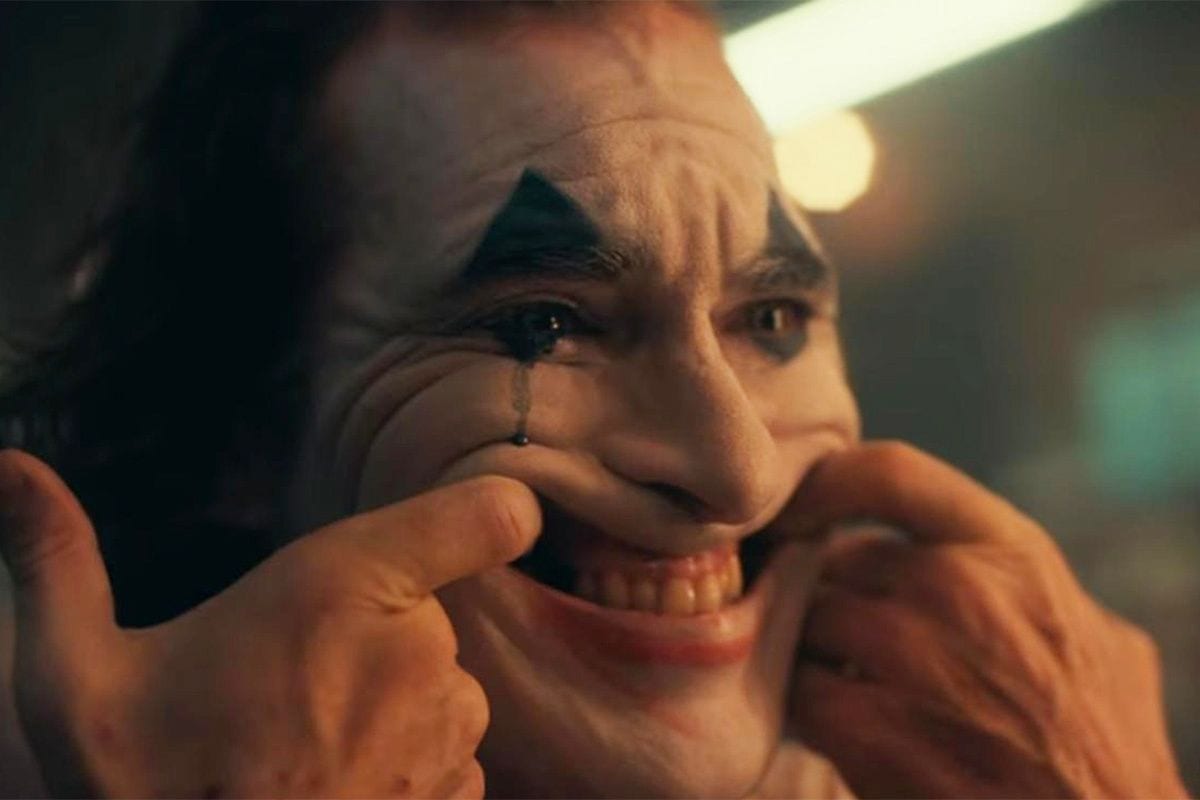Angel Wings by Zorro4 (Pixabay License / Pixabay)
I.
In the by-now iconic still from Todd Phillips’s Joker (2019), the advice “put on a happy face” is scrawled across the dressing-room mirror. Any inspiration from the hackneyed quote instantly evaporates next to the reflection of Joaquin Phoenix fixing his make-up as he’s playing depressed Arthur Fleck, who is in turn playing a murderous merry prankster. Putting on a happy face is Arthur’s daily grind as a rent-a-clown and aspiring stand-up comedian. Of course, happiness eludes everyone in the streets of Gotham, its faint twinkle lost among endless masquerades and mirrors. Yet, ironically, the movie offers a funhouse of distorted images and labyrinthine alternatives to delight viewers.
At first glance, Joker appears to be an origin story of Batman’s nemesis: the mentally unstable Arthur Fleck, neglected or bullied by all around him, kills toxic male stockbrokers on the subway, bludgeons a double-dealing coworker, and plots a vengeful moment of recognition by assassinating talk-show host Murray Franklin (Robert DeNiro) live on Franklin’s show. In the process, Fleck’s newfound alter ego as the Joker becomes the unlikely face of a protest movement against the city’s rich and powerful. The only problem with this view of the movie? None of it may be true.
Arthur’s mother, Penny (Frances Conroy), may not have deceived him when she said he was the son of Thomas Wayne (Brett Cullen). Arthur may have never murdered anyone at all, and his alter ego may not be the face of a protest movement; in fact, there may be no protest movement raging in Gotham at all. Furthermore, there’s room to doubt whether Arthur Fleck even becomes Batman’s nemesis. Phillips has planted a tantalizing trail of clues throughout to upend viewers’ most basic assumptions, presenting a film whose contradictory structure can cause as much mayhem as its titular character. In an age of hot takes and self-assured takedowns, Phillips’s complex film challenges viewers to question their cherished certainties.
II.
The first counternarrative is that Penny’s claim of paternity is true: Arthur, not Bruce, is Thomas Wayne’s first son. The only proof we’re given that Penny’s claim is bogus comes from the documents Arthur steals from inside Arkham Asylum. These documents relate that Penny had narcissistic personality disorder and endured a lobotomy, as well as that Arthur was adopted and tortured as a child by his unnamed stepfather. Presented with the news that his mother has deceived and abused him, Arthur kills her.
Yet, the movie suggests these documents may have been forged, given how rich and well-connected the Wayne family was and how much Thomas would have felt pressure to brush aside an illegitimate heir. Thomas may have nevertheless arranged for a doctor to perform the lobotomy, at once causing Penny’s insanity and preventing her from testifying against him.
Indeed, this theory is backed by actor Brett Cullen in an interview with The Hollywood Reporter. Cullen admits he played the role of Thomas Wayne as if Thomas was the one who put Penny in the institution. Furthermore, Actor Alec Baldwin dropped out of consideration for the role once he heard Phillips wanted Thomas Wayne played like Trump, providing further credence to the idea that Thomas Wayne is gaslighting Penny, whom he now doesn’t care two cents for.
Another clue supporting this theory is Penny’s photo signed “T.W.” with the romantic ascription “love your smile” on the back. As we see this image briefly as Arthur rummages among his mother’s possessions, there’s little reason to think it’s counterfeit. Thus, the film strongly hints that Thomas reciprocated Penny’s feelings at some point in the past, casting doubt on the story Thomas gives Arthur that his mother was merely a crazy lady who once worked for him.
If Arthur really is Thomas Wayne’s first son, then this reconceives Batman as a classic Gothic story about covert lines of inheritance, an ongoing conflict between two would-be heirs for legitimacy. Arthur’s confrontations with a young Bruce and an old Thomas both make more sense under this reading, too, since his animus and vulnerability would be fully motivated when he is trying to reclaim the affection, wealth, and reality he’s been duped out of. In this version, Arthur is not necessarily psychotic; rather, the gaslit world is duplicitous through-and-through. Arthur’s been hoodwinked by the conspiring rich and powerful.
When he unleashes the anarchy that results in Thomas Wayne’s back-alley murder, he also becomes responsible for his father’s death. Arthur orphans himself. He is abandoned and bereft of any tragic recognition of his true state.
III.
Another competing counternarrative is that Arthur has narcissistic personality disorder and that much of the movie has been a sick private joke he’s merely imagined. However, even in this theory, just how much of the movie has been in his head is up for debate.
When the film pulls back to retroactively reveal that Arthur has never dated the woman down the hall, Sophie (Zazie Beetz), and that all the visions of them together were Arthur’s fantasies, what prevents us from attributing other scenes as simply his daydreams, too? Some viewers may want the unreliable narration limited to the scenes where he is dating Sophie, seeing these fantasies as demonstrating how divorced from human connection he is; his lone friend is shown in the end to be an imaginary one.
Yet, little indicates that Arthur’s unreliable narration is so easily contained. One clue may be Sophie’s name itself: incongruously, “sophia” denotes truth in ancient Greek. When the reality of Arthur’s relationship with Sophie vanishes, the rest of the viewer’s hold on what parts of the narrative are true vanishes along with it.
Cinematographically, this blind spot is represented by seeing Arthur performing at Pogo’s Comedy Club from Sophie’s perspective. Later, when Arthur’s disastrous comedy routine goes viral and a clip eventually appears on the Murray Franklin Show, the camera angle indicates that it is also from Sophie’s point of view. Nevertheless, if Sophie was never there, who would bother filming Arthur? In fact, since the events are set in 1981, before cell phone cameras, it’s likely nobody filmed Arthur—and he is concocting an asynchronous vision influenced by social media use decades later.
(IMDB)
Another moment that most viewers attribute to Arthur’s overactive imagination is his first appearance on the Murray Franklin Show. Arthur is watching the television show with his mother when he either remembers or projects a time when Murray picks him from the audience to briefly share the stage on live TV. Arthur has a friendly, father-and-son chat with his idol. Arthur’s earlier appearance on stage, however, is never mentioned later when Arthur is invited on the show as a guest. The scene has the feel of wish-fulfillment, though its status as fantasy is not as definitive as his dates with Sophie.
Corroborating the theory that Arthur may be having vivid and frequent psychotic episodes, Arthur confesses to his social worker halfway through the movie that he has gone off his prescribed dosages of medications. This is a telltale sign of unreliable narration.
The coda-like ending insinuates that much more than the events mentioned above are products of Arthur’s tormented illusions. The final scene, set in a mental asylum, appears to be a break in the film’s framing device. The scene’s bright lighting contrasts with the visually—and morally—gray world of Gotham. Arthur giggles uncontrollably. When his psychiatrist asks him what’s so funny, he refuses to tell her, saying, “You wouldn’t get it.” In this theory, Arthur Fleck is the author of a convoluted yarn in the grand tradition of shaggy-dog stories, and nearly everything that went before this scene is his demented hallucination. He’s teasing us that the rest of the story is his private joke.
And yet, even this moment of truth proves slippery. After his withheld joke, Arthur sings along to the seemingly non-diegetic Frank Sinatra tune “That’s Life”, disconcertingly merging reality and representation. We then see him dancing in the hallway of the asylum, tracking bloody footprints and running from orderlies—a sequence lifted (albeit darkly modified) from Scooby-Doo cartoons or the Keystone Kops. Arthur’s final madcap capering is the most unrealistic scene in the movie, juxtaposed to the film’s gritty noir as if it were a send-up of comic book exuberance. Just when the viewer thinks the film’s reached a stable foundation, the rug gets pulled out once again.
IV.
The final counternarrative is that Arthur Fleck is not Batman’s famed nemesis. After all, the movie is entitled Joker, not The Joker. Arthur Fleck is nowhere else in the canonical Batman universe. And the age difference between Bruce Wayne (Dante Pereira-Olson), who looks ten-years-old at best in the film, and Arthur’s haggard, middle-aged appearance, belies the classic duo’s more contemporaneous timelines.
In this version of Gotham, anyone can become a clown and every clown is merely an empty suit or a painted domino. The subway murderer inspires many in Gotham to wear anonymous clown masks; the visions of whirlwind crowds of masquerading jesters should tip us off that there is no core identity to a farceur. When Arthur, chased by detectives, returns to the subway, the scene of the crime, he becomes lost in a sea of his imitators. To hide among those who are emulating him, he dons another rider’s mask, becoming his own double. The line between clown prince and clone dissolves. Identity is a role to be play-acted, whether its Arthur’s rent-a-clown coworkers putting on greasepaint, his social worker following the same script each week, Murray Franklin reading cue-cards, or Thomas Wayne spitting platitudes.
In a telling moment, one of the detectives asks Arthur whether the card claiming that he has a condition that makes him burst into uncontrollable laughter is “part of his act”. The question raises the specter that everything about Arthur is part of his bag of gags and tricks, a vortex of performance with no bottom. Still, when Arthur contends that the gun he dropped at the children’s hospital was a prop in his act, his lie retroactively becomes true when he later uses the gun during his guest appearance on the Murray Franklin Show. Perform a role consistently, and it’ll stick, much like how someone’s face can become frozen in a grimace, if he makes that expression too often, and holds it for too long.
On the one hand, Joker suggests that Arthur’s confession of killing the stockbrokers on the subway while on the Murray Franklin Show may be his desperate plea for attention. Arthur’s a lonely nutjob trying to take credit for an anonymous shooting that has suddenly galvanized the city. On the other hand, that shooting may be the only real murder he commits, and the subsequent killing spree may be his self-aggrandizing visions after he has been captured and thrown in the mental asylum. Still another reading is that the events leading up to Arthur’s blacking-out in the back of the cop car are true, but his revival and triumphant rise above the crowd as if at last on a grand stage is delusional. If Arthur isn’t Batman’s Joker, then we have no assurance he kills anyone or that he’s ever escaped the asylum. Questions proliferate, and the only answer we get is Arthur’s pained, repeated Cheshire-like grin.
But if Arthur isn’t the Joker from Batman lore, then who is? It’s possible that he inspires some young trickster in Gotham to become his copycat. Or, more likely, there may be no single Joker. Rather, the Joker is a phantasm of facades, an existential cover, a potential for pandemonium that exists in all of us. As if to validate this theory, Arthur lives in apartment 8J, signifying the eight cinematic versions of the Joker. The sinister streets of Gotham are revised with every new twist; the self-aware joke is that Arthur is only one in a long iteration of Jokers. He’s a twice-told twist on an old tale, a pastiche composed from citations of previous characters and roles.
V.
No single theory of Joker can account for what is “real”. Does this mean the movie is muddled or pointless or a sadistic puzzle? Not at all. The film is an artfully constructed work that pushes the limits of unreliable narration. It flips the Batman narrative to examine why a rich playboy is the traditional hero and an outcast rogue’s gallery of psychiatric patients are the conventional villains of the perpetually crime-infested Gotham city. This revisionary take is relevant at a time when we are prone to doubt the wealthy and powerful while sympathizing with those with more heterodox outlooks, even as we insist on policing others according to our personal values and viewpoints.
Joker helps bring into focus many important questions of our tumultuous zeitgeist, be they aesthetic debates about an audience’s relationship to an antihero, political debates about individual versus systemic responsibility, or philosophical debates about the social construction of truth. At the same time, the film’s ambiguities present a compelling conversation piece. When Arthur’s diatribe gets booed on the Murray Franklin Show, he tells the audience “humor is subjective”. Likewise, any considered response to the film’s divergent interpretations force us to acknowledge our own subjectivity. One thing is clear: Joker is designed to provoke a recognition that one’s own views are incomplete. Even the most marginalized, silenced, or self-censored among us may have a perspective worth considering. Joker ensures that nobody gets the last laugh.
* * *
Additional Source Cited
Burton, Byron . “Joker Actor Brett Cullen on Thomas Wayne’s Secret Actor Brett Cullen on Thomas Wayne’s Secret“. The Hollywood Reporter, 5 October 2019.



